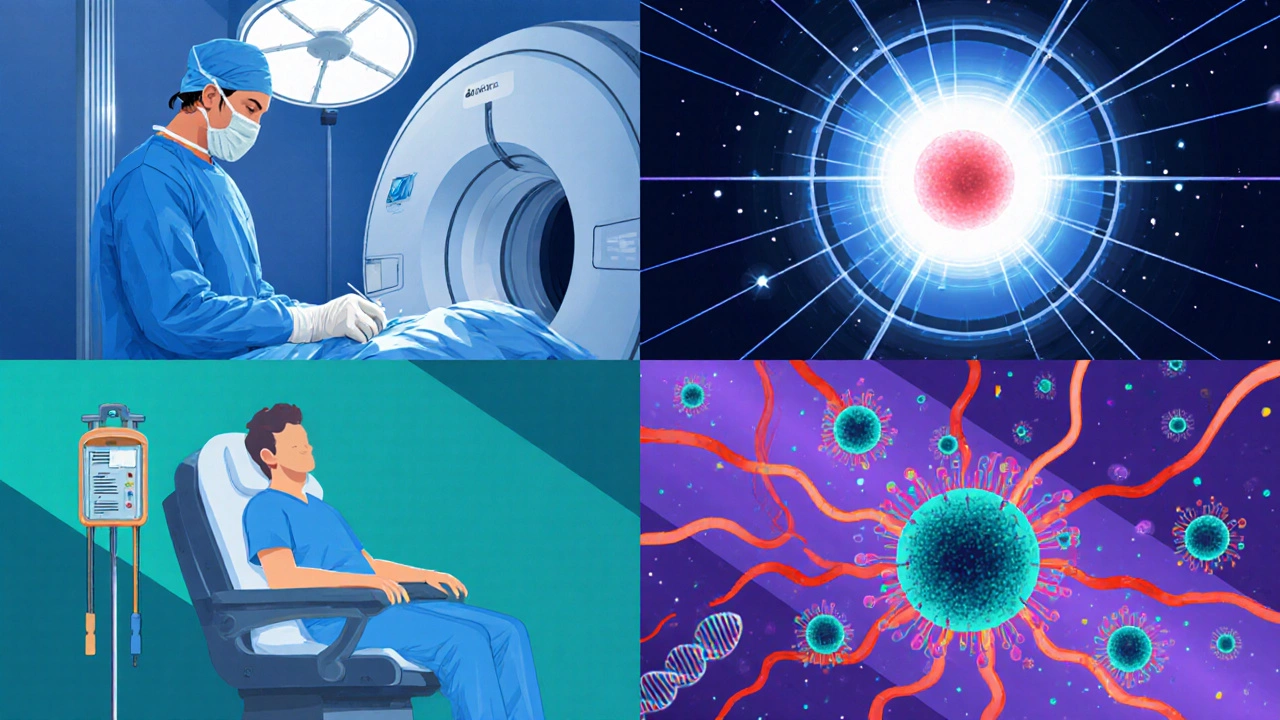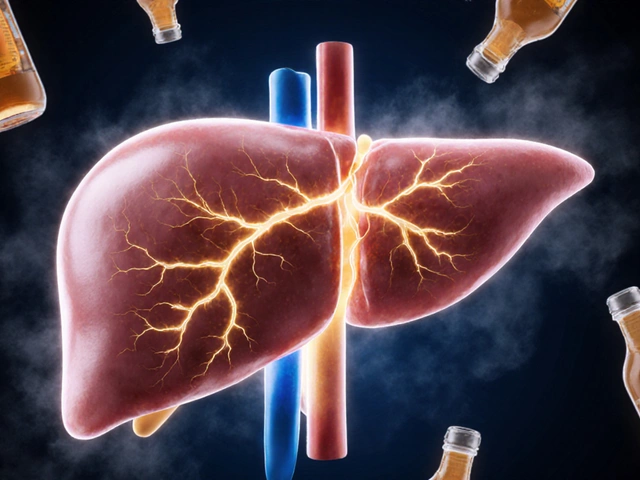Cancer Survival Rate Calculator
Understand Your Cancer Survival Rates
Select your cancer stage to see the typical 5-year survival rates and treatment options based on U.S. statistics.
Key Takeaways
- "100% cure" is a statistical ideal, not a guaranteed outcome for every patient.
- Early-stage cancers have 5‑year survival rates above 90% for many types, while advanced disease drops dramatically.
- Modern treatments-surgery, radiation, chemotherapy, immunotherapy, and targeted therapy-can eradicate many tumors, but success depends on tumor biology and patient factors.
- Clinical trials and personalized medicine are expanding the ceiling of what we call "cure," but no single therapy promises 100% certainty.
- Staying informed, seeking second opinions, and adopting healthy lifestyle habits improve the odds of long‑term remission.
What Does "100% Beat Cancer" Really Mean?
When an article asks if you can beat cancer, most readers picture a magic bullet that works for everyone. In medical terms, "cure" usually means no evidence of disease (NED) for at least five years after treatment. That five‑year window is a statistical benchmark, not a promise that the disease will never return.
To understand the limits, we need to examine how oncologists measure success. Survival statistics are reported as percentages that aggregate large patient groups. Even a 99% cure rate means one out of a hundred patients experiences recurrence or death. So the phrase "100% beat cancer" is more of a hope than a measurable reality.

Current Success Rates by Cancer Stage
| Stage | Typical Treatments | 5‑Year Survival % (U.S.) | Notes |
|---|---|---|---|
| 0 (Carcinoma in situ) | Surgery alone | ≈99 | Often cured with removal of the lesion. |
| I (Localized) | Surgery ± Radiation | 80‑95 | High cure potential if detected early. |
| II (Regional spread) | Surgery + Radiation ± Chemotherapy | 60‑80 | Combination therapy improves odds. |
| III (Locally advanced) | Multi‑modal: Surgery, Radiation, Chemotherapy, Targeted therapy | 30‑60 | Long‑term remission possible but less frequent. |
| IV (Metastatic) | Systemic therapy (Chemotherapy, Immunotherapy, Targeted agents) + Palliative care | 5‑15 | Cure is rare; focus shifts to disease control. |
How Modern Treatments Work
Today’s oncology arsenal combines several approaches, each targeting cancer in a different way.
- Chemotherapy is a systemic treatment that uses drugs to kill rapidly dividing cells, both cancerous and some healthy ones. It remains the backbone for many solid tumors and hematologic cancers.
- Immunotherapy harnesses the body’s immune system to recognise and destroy cancer cells. Checkpoint inhibitors such as pembrolizumab have turned once‑incurable melanoma into a disease with long‑term remission for many patients.
- Radiation therapy delivers high‑energy rays to a precise tumor location, damaging DNA and preventing replication. It’s often paired with surgery to eradicate microscopic disease.
- Surgical oncology physically removes the tumour and surrounding tissue, offering the best chance of cure when the cancer is confined.
- Targeted therapy blocks specific molecular pathways that drive tumour growth, such as HER2 in breast cancer or EGFR in lung cancer.
Choosing the right mix depends on tumour type, stage, genetic mutations, and the patient’s overall health.

Key Factors That Influence the Chance of a Cure
- Early detection dramatically improves outcomes. Tumours caught before they spread are often removable with surgery alone.
- Tumour biology - some cancers (e.g., pancreatic, glioblastoma) are intrinsically aggressive, while others (e.g., prostate, thyroid) tend to grow slowly.
- Genetic biomarkers - mutations like BRCA1/2 or KRAS guide targeted therapy selection, affecting response rates.
- Patient age and comorbidities - younger, healthier patients can tolerate aggressive multimodal regimens.
- Access to specialised care - high‑volume cancer centers report higher cure rates thanks to multidisciplinary expertise.
Why a Universal 100% Cure Remains Out of Reach
Cancer isn’t a single disease; it’s a collection of over 200 distinct disorders, each with its own genetic landscape. Even within one tumour type, heterogeneity means some cells respond to treatment while others survive, leading to relapse.
Moreover, metastasis-the spread of cancer cells to distant organs-creates microscopic disease that can hide from surgery and radiation. Current systemic therapies can shrink or control these cells, but eliminating every last cancer cell is extraordinarily difficult.
That’s why oncologists talk about "curative intent" rather than a guaranteed 100% cure. The goal is to maximise the proportion of patients who achieve long‑term remission, while acknowledging that a small fraction will experience recurrence.

Emerging Approaches That Push the Boundaries
Research is constantly shifting the goalposts. Here are the most promising developments that could raise cure rates in the next decade.
- CAR‑T cell therapy re‑engineers a patient’s T‑cells to target specific cancer antigens. It has produced durable remissions in certain leukemias, with cure rates approaching 50% in heavily pre‑treated patients.
- Liquid biopsies detect circulating tumor DNA, enabling earlier detection of minimal residual disease and timely intervention before relapse.
- Personalized vaccines tailored to a patient’s unique tumor mutations aim to educate the immune system to hunt down every cancer cell.
- Combination immunotherapy-using two or more checkpoint inhibitors or pairing them with targeted agents-has shown synergistic effects in melanoma and lung cancer.
- Clinical trial participation grants access to cutting‑edge therapies before they enter standard practice. Trials often report higher response rates than historical controls.
While these advances are exciting, they still operate within the reality that no single treatment can guarantee eradication for every patient.
Practical Steps to Optimize Your Chances
- Get screened according to recommended guidelines (e.g., colonoscopy at 45, mammography at 40).
- If diagnosed, ask for a multidisciplinary tumor board review to ensure all viable options are considered.
- Consider reputable clinical trials-use ClinicalTrials.gov or ask your oncologist for matches.
- Maintain a healthy lifestyle: balanced diet, regular exercise, and quitting smoking can improve treatment tolerance and possibly reduce recurrence.
- Stay informed about follow‑up schedules. Early detection of recurrence improves salvage treatment success.
Remember, beating cancer is a partnership between you, your care team, and the science that keeps advancing.
Frequently Asked Questions
Can any cancer be completely cured?
Cure rates vary widely. Early‑stage breast, prostate, thyroid, and skin cancers often have >90% five‑year survival, while metastatic pancreatic or brain cancers have <10%.
What does “no evidence of disease” really mean?
It means current imaging and lab tests cannot find cancer cells. It’s a statistical benchmark, not an absolute guarantee that hidden cells don’t exist.
Is immunotherapy better than chemotherapy?
Immunotherapy works for cancers that express certain checkpoints, often with fewer side‑effects. Chemotherapy remains essential for many solid tumors, especially when rapid tumor shrinkage is needed.
How can I find a relevant clinical trial?
Start at ClinicalTrials.gov, filter by cancer type, stage, and location, then discuss promising options with your oncologist.
Does a healthy lifestyle actually affect cancer outcomes?
Studies show that regular exercise, weight control, and limited alcohol intake improve overall survival and reduce recurrence risk for several cancers.






